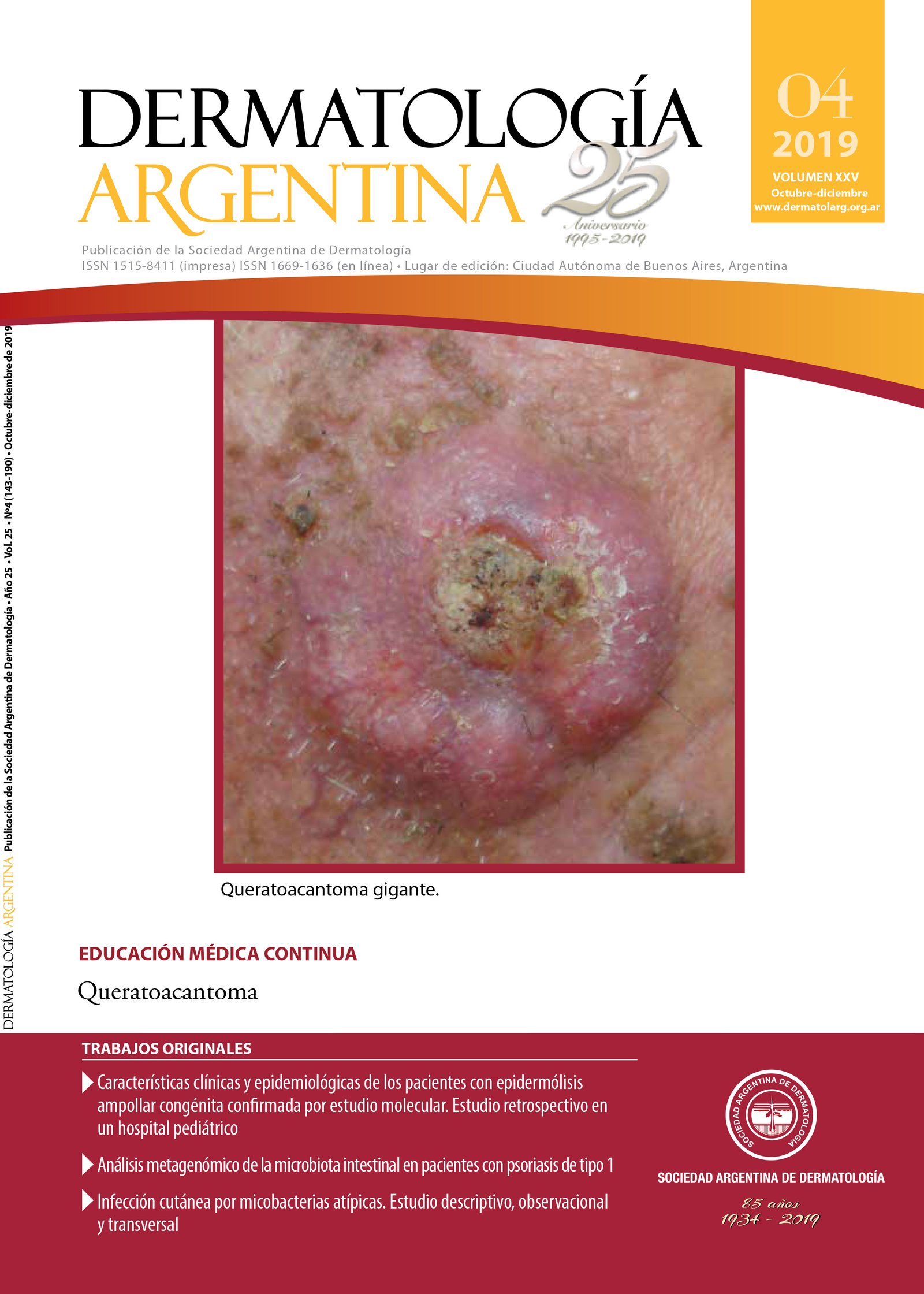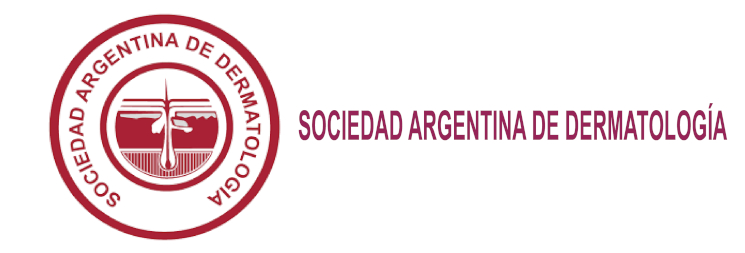Análisis metagenómico de la microbiota intestinal en pacientes con psoriasis de tipo 1
Palabras clave:
psoriasis, microbiota intestinal, metagenómicaResumen
Introducción: La psoriasis es una enfermedad inflamatoria crónica inmunomediada. La psoriasis tipo 1 (Ps1) o psoriasis de inicio temprano es la forma más frecuente de psoriasis y presenta una fuerte base genética. La microbiota intestinal está implicada en la maduración del sistema inmunitario y en múltiples vías metabólicas. Los trastornos en la composición bacteriana intestinal o disbiosis conllevan importantes consecuencias funcionales y han sido implicados en múltiples enfermedades.
El objetivo del estudio fue evaluar las diferencias en la microbiota intestinal de pacientes con Ps1 frente a sujetos de control no psoriásicos (SC).
Materiales y métodos: Se estudiaron 38 pacientes con Ps1 sin tratamiento y 27 SC. Se recolectaron muestras de materia fecal y se analizaron las regiones hipervariables V3-V4 del gen 16S rRNA, que fueron analizadas mediante la plataforma de secuenciación Illumina MiSeq para determinar la composición y la diversidad microbianas. Se realizó un análisis bioinformático.
Resultados: No se encontraron diferencias en biodiversidad (diversidad alfa) entre los pacientes con Ps1 y los SC. El análisis de la diversidad beta mostró diferencias significativas entre ambos grupos (p = 0,032). Al comparar los principales filos, solo el aumento relativo de Firmicutes en Ps1 mostró diferencias significativas (p < 0,05). El análisis LEfSe reveló mayor abundancia de los géneros Faecalibacterium y Blautia en pacientes con Ps1 y los géneros Bacteroides, Paraprevotella, Odoribacter, Anaerotruncus y Oscillospira en SC.
Conclusiones: Los resultados demuestran diferencias en la microbiota intestinal de los pacientes con Ps1 y en los SC, lo que implicaría que la microbi-ota intestinal ejerce una función por dilucidar en la patogenia de la psoriasis.
Citas
I. Griffiths CEM, Barker JN. Pathogenesis and clinical features of psoriasis. Lancet. 2007;370:263-271.
II. Boehncke W-H, Schön MP. Psoriasis. Lancet. 2015;386:983-994.
III. Lønnberg AS, Skov L, Duffy DL, Skytthe A, et ál. Genetic factors explain variation in the age at onset of psoriasis: a population-based twin study. Acta Derm Venereol. 2016;96:35-38.
IV. Henseler T, Christophers E. Psoriasis of early and late onset: Characterization of two types of psoriasis vulgaris. J Am Acad Dermatol. 1985;13:450-456.
V. Wiśniewski A, Matusiak Ł, Szczerkowska-Dobosz A, Nowak I, et ál. The association of ERAP1 and ERAP2 single nucleotide polymorphisms and their haplotypes with psoriasis vulgaris is dependent on the presence or absence of the HLA-C*06:02 allele and age at disease onset. Hum Immunol. 2018;79:109-116.
VI. Singh S, Pradhan D, Puri P, Ramesh V, et ál. Genomic alterations driving psoriasis pathogenesis. Gene. 2019;683:61-71.
VII. Huttenhower C, Gevers D, Knight R, Abubucker S, et ál. Structure, function and diversity of the healthy human microbiome. Nature. 2012;486:207-214.
VIII. Salem I, Ramser A, Isham N, Ghannoum MA. The gut microbiome as a major regulator of the gut-skin axis. Front. Microbiol. 2018;9:1459.
IX. Takeshita J, Grewal S, Langan SM, Mehta NN, et ál. Psoriasis and comorbid diseases: Epidemiology. J Am Acad Dermatol. 2017;76:377-390.
X. Ramírez-Boscá A, Navarro-López V, Martínez-Andrés A, Such J, et ál. Identification of bacterial DNA in the peripheral blood of patients with active psoriasis. JAMA Dermatol. 2015;151:670-671.
XI. Blauvelt A, Chiricozzi A. The immunologic role of IL-17 in psoriasis and psoriatic arthritis pathogenesis. Clin Rev Allergy Immunol. 2018;55:379-390.
XII. Zákostelská Z, Málková J, Klimešová K, Rossman P, et ál. Intestinal microbiota promotes psoriasis-like skin inflammation by enhancing Th17 response. PLoS One. 2016;11:e0159539.
XIII. Sender R, Fuchs S, Milo R. Are we really vastly outnumbered? revisiting the ratio of bacterial to host cells in humans. Cell. 2016;164:337-340.
XIV. Turnbaugh PJ, Ley RE, Hamady M, Fraser-Liggett CM, et ál. The human microbiome project. Nature. 2007;449:804-810.
XV. Blaut M. Composition and Function of the Gut Microbiome. The Gut Microbiome in Health and Disease. 2018:5-30.
XVI. Turnbaugh PJ, Hamady M, Yatsunenko T, Cantarel BL, et ál. A core gut microbiome in obese and lean twins. Nature. 2009;457:480-484.
XVII. Li D, Wang P, Wang P, Hu X, et ál. The gut microbiota: A treasure for human health. Biotechnol Adv. 2016;34:1210-1224.
XVIII. Levy M, Kolodziejczyk AA, Thaiss CA, Elinav E. Dysbiosis and the immune system. Nat Rev Immunol. 2017;17:219-232.
XIX. Ni J, Wu GD, Albenberg L, Tomov VT. Gut microbiota and IBD: causation or correlation? Nat Rev Gastroenterol Hepatol. 2017;14:573-584.
XX. Maruvada P, Leone V, Kaplan LM, Chang EB. The human microbiome and obesity: moving beyond associations. Cell Host Microbe. 2017;22:589-599.
XXI. Patterson E, Ryan PM, Cryan JF, Dinan TG, et ál. Gut microbiota, obesity and diabetes. Postgrad Med J. 2016;92:286-300.
XXII. Tremlett H, Bauer KC, Appel-Cresswell S, Finlay BB, et ál. The gut microbiome in human neurological disease: A review. Ann Neurol. 2017;81:369-382.
XXIII. Song H, Yoo Y, Hwang J, Na Y-C, et ál. Faecalibacterium prausnitzii subspecies-level dysbiosis in the human gut microbiome underlying atopic dermatitis. J Allergy Clin Immunol. 2016;137:852-860.
XXIV. Saha A, Robertson ES. Microbiome and Human Malignancies. En Robertson E. (eds) Microbiome and Cancer. Current Cancer Research. Humana Press, Cham. 2019: 1-22.
XXV. Codoñer FM, Ramírez-Bosca A, Climent E, Carrión-Gutierrez M, et ál. Gut microbial composition in patients with psoriasis. Sci Rep. 2018;8:3812.
XXVI. Huang L, Gao R, Yu N, Zhu Y, et ál. Dysbiosis of gut microbiota was closely associated with psoriasis. Sci China Life Sci. 2019;62:807-815.
XXVII. Shapiro J, Cohen NA, Shalev V, Uzan A, et ál. Psoriatic patients have a distinct structural and functional fecal microbiota compared with controls. J Dermatol. 2019;46:595-603.
XXVIII. Tan L, Zhao S, Zhu W, Wu L, et ál. The Akkermansia muciniphila is a gut microbiota signature in psoriasis. Exp Dermatol. 2018;27:144-149.
XXIX. Scher JU, Ubeda C, Artacho A, Attur M, et ál. Decreased bacterial diversity characterizes the altered gut microbiota in patients with psoriatic arthritis, resembling dysbiosis in inflammatory bowel disease. Arthritis Rheumatol. 2015;67:128-139.
XXX. Hidalgo‐Cantabrana C, Gómez J, Delgado S, Requena López S, et ál. Gut microbiota dysbiosis in a cohort of patients with psoriasis. Br J Dermatol. 2019;181:1287-1295.
XXXI. Chen YJ, Ho HJ, Tseng CH, Lai ZL, et ál. Intestinal microbiota profiling and predicted metabolic dysregulation in psoriasis patients. Exp Dermatol. 2018;27:1336-1343.
XXXII. Goodrich JK, Waters JL, Poole AC, Sutter JL, et ál. Human genetics shape the gut microbiome. Cell. 2014;159:789-799.
XXXIII. Dillon SM, Frank DN, Wilson CC. The gut microbiome and HIV-1 pathogenesis: a two-way street. AIDS. 2016;30:2737-2751.
XXXIV. Bach Knudsen KE, Lærke HN, Hedemann MS, Nielsen TS, et ál. Impact of diet-modulated butyrate production on intestinal barrier function and inflammation. Nutrients. 2018;10:1499.
XXXV. Zhou L, Zhang M, Wang YT, Dorfman RG, et ál. Faecalibacterium prausnitzii produces butyrate to maintain Th17/Treg balance and to ameliorate colorectal colitis by inhibiting histone deacetylase 1. Inflamm Bowel Dis. 2018;24:1926-1940.
XXXVI. Eppinga H, Sperna Weiland CJ, Bing Thio H, van der Woude CJ, et ál. Similar depletion of protective faecalibacterium prausnitziiin psoriasis and inflammatory bowel disease, but not in hidradenitis suppurativa. J Crohns Colitis. 2016;10:1067-1075.
XXXVII. Kosiewicz MM, Dryden GW, Chhabra A, Alard P. Relationship between gut microbiota and development of T cell associated disease. FEBS Lett. 2014;588:4195-4206.
Descargas
Publicado
Número
Sección
Licencia
El/los autor/es tranfieren todos los derechos de autor del manuscrito arriba mencionado a Dermatología Argentina en el caso de que el trabajo sea publicado. El/los autor/es declaran que el artículo es original, que no infringe ningún derecho de propiedad intelectual u otros derechos de terceros, que no se encuentra bajo consideración de otra revista y que no ha sido previamente publicado.
Le solicitamos haga click aquí para imprimir, firmar y enviar por correo postal la transferencia de los derechos de autor













